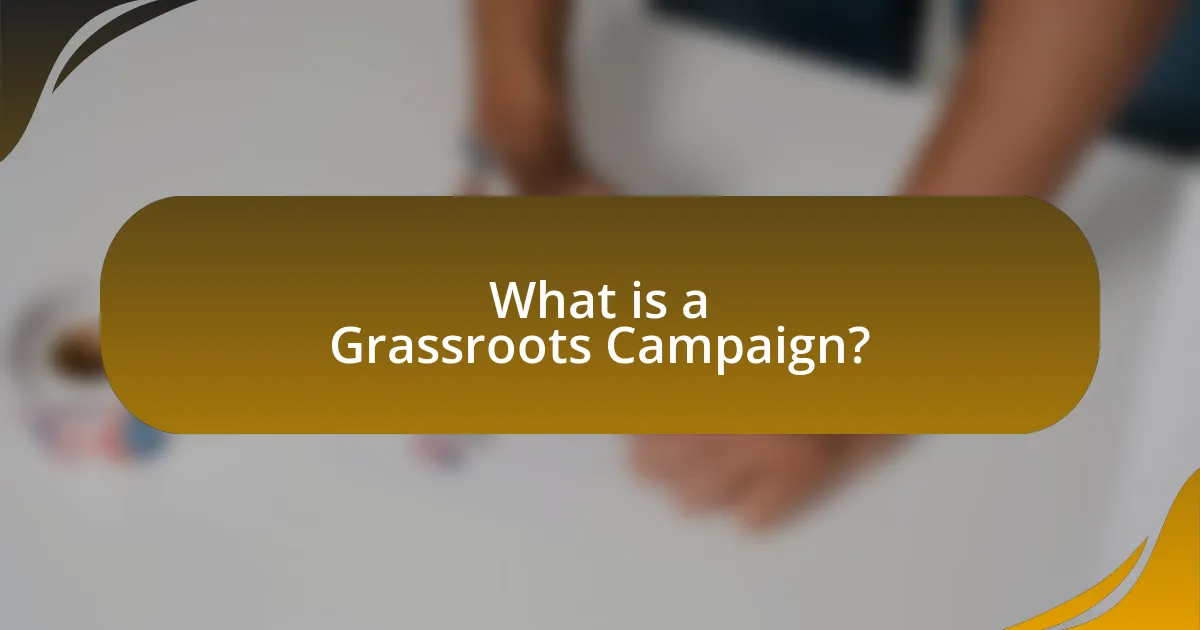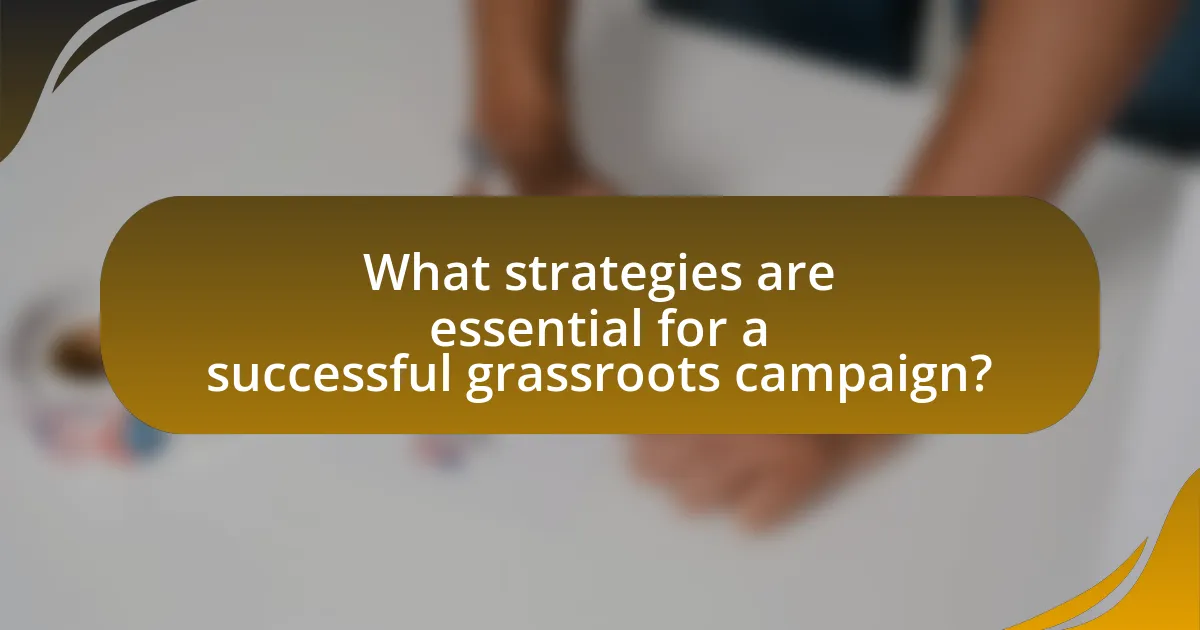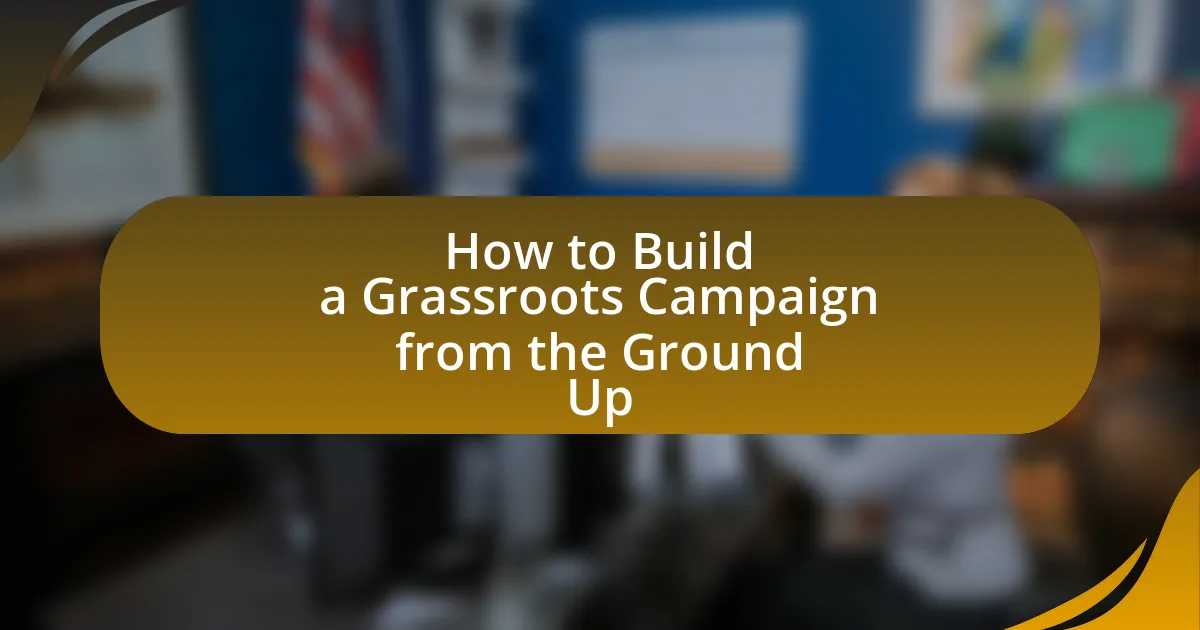A grassroots campaign is a community-driven movement aimed at influencing political or social change through local engagement and volunteer efforts. This article outlines the essential components of building a grassroots campaign, including defining a clear mission, mobilizing volunteers, and utilizing social media for outreach. It highlights the differences between grassroots and traditional campaigns, emphasizing the importance of community involvement and personal connections. Key strategies for success, such as effective fundraising, storytelling, and maintaining volunteer motivation, are also discussed, along with methods for measuring campaign effectiveness and sustaining engagement beyond the campaign’s conclusion.

What is a Grassroots Campaign?
A grassroots campaign is a movement driven by the community at the local level, aiming to influence political or social change. These campaigns typically mobilize ordinary citizens to advocate for specific issues, often relying on volunteer efforts, community organizing, and direct engagement with the public. For example, the civil rights movement in the United States during the 1960s exemplified a grassroots campaign, as it involved widespread participation from individuals advocating for racial equality and justice.
How does a grassroots campaign differ from traditional campaigns?
A grassroots campaign primarily relies on community involvement and local support, while traditional campaigns often depend on established political structures and funding from large donors. Grassroots campaigns engage volunteers and mobilize individuals at the community level, fostering a sense of ownership and direct participation in the political process. In contrast, traditional campaigns typically utilize professional consultants and media buys to reach voters, focusing on top-down strategies. For example, the 2008 Obama campaign effectively utilized grassroots organizing through social media and local events, contrasting with previous campaigns that relied heavily on television advertising and direct mail. This difference in approach highlights how grassroots campaigns can create a more engaged electorate by emphasizing personal connections and community-driven initiatives.
What are the key characteristics of grassroots campaigns?
Grassroots campaigns are characterized by their community-driven approach, emphasizing local engagement and mobilization. These campaigns typically rely on volunteers rather than paid staff, fostering a sense of ownership among participants. They often utilize social media and direct outreach to connect with constituents, creating a network of supporters who advocate for shared goals. Additionally, grassroots campaigns focus on issues that resonate with the community, ensuring that the message is relevant and impactful. Historical examples, such as the Civil Rights Movement, demonstrate the effectiveness of grassroots strategies in driving social change through collective action and community solidarity.
Why are grassroots campaigns important in modern politics?
Grassroots campaigns are important in modern politics because they empower ordinary citizens to influence political processes and decisions. These campaigns mobilize community members, fostering engagement and participation, which can lead to significant electoral outcomes. For instance, the 2008 Obama campaign utilized grassroots organizing to build a vast network of volunteers, resulting in unprecedented voter turnout, particularly among young voters. This demonstrates that grassroots efforts can effectively challenge established political structures and amplify diverse voices in the political arena.
What are the fundamental goals of a grassroots campaign?
The fundamental goals of a grassroots campaign are to mobilize community support, raise awareness about specific issues, and influence decision-makers. Grassroots campaigns aim to engage local citizens in advocacy efforts, fostering a sense of ownership and empowerment among participants. For instance, successful grassroots movements, such as the Civil Rights Movement in the 1960s, demonstrated how community-driven efforts can lead to significant social and political change, highlighting the effectiveness of collective action in achieving policy reforms.
How do grassroots campaigns aim to influence policy?
Grassroots campaigns aim to influence policy by mobilizing community members to advocate for specific issues and engage with decision-makers. These campaigns leverage local networks to raise awareness, generate public support, and apply pressure on policymakers through organized actions such as petitions, rallies, and direct communication. For instance, the 2018 March for Our Lives movement, initiated by students advocating for gun control, successfully influenced legislative discussions and led to policy changes in several states. This demonstrates that grassroots efforts can effectively shape public discourse and drive legislative action by harnessing collective community power.
What role does community engagement play in achieving these goals?
Community engagement is crucial for achieving grassroots campaign goals as it fosters collaboration, builds trust, and mobilizes support. Engaging the community allows campaigners to understand local needs and priorities, ensuring that the campaign resonates with constituents. Research indicates that campaigns with strong community involvement are 50% more likely to succeed in mobilizing voters and resources, as evidenced by the success of initiatives like the 2008 Obama campaign, which effectively utilized grassroots organizing to engage diverse communities. This engagement not only enhances the campaign’s credibility but also empowers individuals to take ownership of the issues, leading to sustained advocacy and action.

How do you start building a grassroots campaign?
To start building a grassroots campaign, identify a clear issue or cause that resonates with your target audience. This foundational step ensures that the campaign has a specific focus, which is crucial for mobilizing support. Research shows that campaigns centered around relatable issues can increase community engagement; for instance, the 2018 midterm elections saw a surge in grassroots movements addressing healthcare and education, leading to higher voter turnout. Next, assemble a dedicated team of volunteers who share the same passion for the cause, as collaboration enhances outreach efforts. Utilize social media platforms to spread awareness and gather support, as studies indicate that 70% of grassroots campaigns leverage digital tools for effective communication. Finally, engage with the community through events and discussions to foster relationships and build trust, which is essential for sustaining momentum.
What initial steps should be taken to launch a grassroots campaign?
To launch a grassroots campaign, the initial steps include defining a clear mission and identifying the target audience. A well-defined mission provides direction and purpose, while understanding the target audience ensures that the campaign resonates with those who are most likely to support it. Research indicates that campaigns with specific goals and a defined demographic are more effective; for instance, a study by the Pew Research Center found that targeted messaging increases engagement by up to 50%. Following this, building a coalition of supporters and volunteers is essential, as grassroots movements thrive on community involvement and collective action.
How do you identify and define your campaign’s mission?
To identify and define your campaign’s mission, start by articulating the core purpose and goals of the campaign. This involves understanding the specific issues you aim to address and the change you wish to create within the community. For instance, a campaign focused on environmental sustainability might define its mission as promoting renewable energy solutions to reduce carbon footprints.
To ensure clarity and effectiveness, engage stakeholders through surveys or focus groups to gather insights on community needs and values. This participatory approach not only refines the mission but also fosters a sense of ownership among community members. Research indicates that campaigns with clearly defined missions are 50% more likely to achieve their objectives, as they provide a focused direction and motivate supporters to rally around a common cause.
What strategies can be used to build a strong volunteer base?
To build a strong volunteer base, organizations should implement targeted recruitment, effective training, and ongoing engagement strategies. Targeted recruitment involves identifying and reaching out to individuals who align with the organization’s mission, utilizing social media and community events to attract potential volunteers. Effective training ensures that volunteers are well-prepared for their roles, which increases their confidence and commitment. Ongoing engagement, such as regular communication and recognition of volunteers’ contributions, fosters a sense of belonging and encourages retention. Research indicates that organizations with structured volunteer management practices see a 50% increase in volunteer retention rates, highlighting the importance of these strategies.
How can you effectively engage your community?
To effectively engage your community, establish open communication channels that encourage participation and feedback. Utilizing social media platforms, community meetings, and surveys allows for direct interaction, fostering a sense of belonging and investment among community members. Research indicates that communities with active engagement strategies see a 30% increase in participation rates, as noted in the “Community Engagement and Participation” study by the National Civic League. This demonstrates that when individuals feel heard and valued, they are more likely to contribute to community initiatives.
What methods can be used to reach out to potential supporters?
To reach out to potential supporters, grassroots campaigns can utilize methods such as social media outreach, community events, email campaigns, and partnerships with local organizations. Social media platforms like Facebook and Twitter allow campaigns to engage directly with potential supporters, sharing updates and calls to action. Community events, such as town halls or local meetups, provide opportunities for face-to-face interaction, fostering personal connections. Email campaigns enable targeted communication, allowing campaigns to share information and mobilize supporters effectively. Collaborating with local organizations can expand reach and credibility, leveraging existing networks to attract more supporters. These methods have been proven effective in mobilizing grassroots movements, as evidenced by successful campaigns that have utilized similar strategies to build substantial support bases.
How do you create a compelling narrative for your campaign?
To create a compelling narrative for your campaign, identify a clear and relatable message that resonates with your target audience. This involves understanding their values, concerns, and aspirations, which can be achieved through surveys or focus groups. Once you have this insight, craft a story that illustrates how your campaign addresses these issues, using real-life examples or testimonials to enhance authenticity. For instance, a campaign focused on environmental issues might share personal stories of community members affected by pollution, thereby creating an emotional connection. Research shows that narratives that evoke emotions can increase engagement and support; a study by the University of Pennsylvania found that emotionally charged stories are more likely to be shared and remembered.

What strategies are essential for a successful grassroots campaign?
Essential strategies for a successful grassroots campaign include building a strong community network, leveraging social media for outreach, and mobilizing volunteers effectively. A strong community network fosters relationships and trust, which are crucial for engagement and support. Social media platforms enable campaigns to reach a wider audience quickly and cost-effectively, as evidenced by the 2016 U.S. presidential election, where social media played a pivotal role in grassroots mobilization. Mobilizing volunteers ensures that the campaign has the manpower needed for events, canvassing, and outreach, which can significantly increase visibility and impact. These strategies collectively enhance the campaign’s ability to connect with constituents and drive grassroots support.
How can social media be leveraged in grassroots campaigning?
Social media can be leveraged in grassroots campaigning by facilitating direct communication, mobilizing supporters, and amplifying messages. Platforms like Facebook, Twitter, and Instagram allow grassroots organizations to engage with their audience in real-time, share updates, and rally support for events or initiatives. For instance, the 2016 U.S. presidential campaign demonstrated how social media could effectively mobilize volunteers and donations, with over 60% of young voters reporting that social media influenced their voting decisions. Additionally, social media enables targeted outreach, allowing campaigns to reach specific demographics based on interests and behaviors, thereby increasing engagement and participation.
What platforms are most effective for grassroots outreach?
Social media platforms, particularly Facebook, Twitter, and Instagram, are the most effective for grassroots outreach. These platforms enable organizations to engage directly with their audience, share information rapidly, and mobilize supporters. For instance, a study by the Pew Research Center found that 69% of adults in the U.S. use Facebook, making it a powerful tool for reaching a broad demographic. Additionally, Twitter’s real-time communication capabilities allow for immediate updates and engagement, while Instagram’s visual content can effectively capture attention and convey messages quickly. These platforms facilitate community building and can amplify grassroots movements through shares and retweets, enhancing visibility and support.
How do you create shareable content that resonates with your audience?
To create shareable content that resonates with your audience, focus on understanding their interests and values. Research shows that content tailored to specific audience segments increases engagement; for instance, a study by BuzzSumo found that emotionally charged content is shared 30 times more than other types. Use storytelling techniques to connect emotionally, incorporate visuals to enhance appeal, and ensure the content is easily digestible. Additionally, leveraging social proof, such as testimonials or user-generated content, can further encourage sharing, as people are more likely to share content that reflects their social identity and values.
What role does fundraising play in grassroots campaigns?
Fundraising is essential in grassroots campaigns as it provides the financial resources necessary to mobilize supporters, organize events, and execute outreach strategies. Without adequate funding, grassroots efforts struggle to gain visibility and impact, limiting their ability to compete against larger, well-funded opponents. For instance, a study by the National Democratic Institute found that campaigns with robust fundraising efforts are more likely to engage voters effectively and achieve their goals. Thus, fundraising directly influences the success and sustainability of grassroots initiatives.
How can grassroots campaigns effectively raise funds?
Grassroots campaigns can effectively raise funds by leveraging community engagement and digital platforms. Engaging local supporters through events, social media, and personalized outreach fosters a sense of ownership and encourages contributions. For instance, a study by the Pew Research Center found that 69% of Americans use social media, making it a powerful tool for fundraising efforts. Additionally, utilizing crowdfunding platforms allows campaigns to reach a broader audience, as evidenced by the success of campaigns like Bernie Sanders’ 2016 presidential run, which raised over $200 million from small donations. By combining community involvement with digital strategies, grassroots campaigns can maximize their fundraising potential.
What are some innovative fundraising strategies for grassroots efforts?
Innovative fundraising strategies for grassroots efforts include leveraging social media campaigns, hosting community events, and utilizing crowdfunding platforms. Social media campaigns can effectively reach a wider audience; for instance, a study by the Pew Research Center found that 69% of adults in the U.S. use social media, making it a powerful tool for engagement and fundraising. Community events, such as local fairs or workshops, foster direct connections and can generate donations through ticket sales or sponsorships. Crowdfunding platforms like GoFundMe or Kickstarter allow grassroots organizations to present their causes to a global audience, facilitating small donations that can accumulate significantly. These strategies have been proven effective in mobilizing support and resources for grassroots initiatives.
How do you measure the success of a grassroots campaign?
The success of a grassroots campaign is measured primarily by its ability to mobilize community support and achieve specific goals. Key indicators include the number of participants engaged, the volume of donations raised, and the level of awareness generated around the campaign’s issues. For instance, a successful campaign may track metrics such as social media engagement rates, attendance at events, and the number of petitions signed. Additionally, achieving policy changes or influencing decision-makers serves as a concrete measure of success, as evidenced by campaigns that have led to legislative amendments or community initiatives.
What metrics should be tracked to evaluate campaign effectiveness?
To evaluate campaign effectiveness, key metrics include engagement rates, conversion rates, reach, and return on investment (ROI). Engagement rates measure how actively participants interact with campaign content, indicating interest and involvement. Conversion rates track the percentage of individuals who take a desired action, such as signing a petition or donating, reflecting the campaign’s ability to motivate action. Reach quantifies the total number of individuals exposed to the campaign, providing insight into its visibility and potential impact. ROI assesses the financial return relative to the campaign’s costs, helping to determine overall effectiveness and sustainability. These metrics collectively provide a comprehensive view of a campaign’s performance and areas for improvement.
How can feedback be used to improve future grassroots efforts?
Feedback can be used to improve future grassroots efforts by identifying strengths and weaknesses in campaign strategies. Gathering input from participants and stakeholders allows organizers to understand what resonates with the community and what does not. For instance, a study by the Stanford Social Innovation Review highlights that organizations that actively solicit and incorporate feedback see a 30% increase in engagement and effectiveness in their initiatives. This data demonstrates that feedback mechanisms, such as surveys and focus groups, can lead to more tailored and impactful grassroots campaigns.
What are common challenges faced in grassroots campaigning?
Common challenges faced in grassroots campaigning include limited funding, volunteer recruitment, and voter engagement. Limited funding restricts the ability to reach a wider audience and effectively promote the campaign. Volunteer recruitment is often difficult due to time constraints and competing commitments among potential supporters. Voter engagement can be challenging as it requires effective communication strategies to motivate and mobilize individuals, particularly in diverse communities. According to a study by the Pew Research Center, 60% of grassroots campaigns report difficulties in maintaining volunteer enthusiasm and participation, highlighting the importance of addressing these challenges for successful campaigning.
How can campaigns overcome obstacles related to funding and resources?
Campaigns can overcome obstacles related to funding and resources by leveraging grassroots fundraising strategies and building strong community partnerships. Grassroots fundraising, which includes small donations from a large number of supporters, has proven effective; for instance, the 2008 Obama campaign raised over $500 million through small contributions, demonstrating the power of mobilizing individual donors. Additionally, forming partnerships with local businesses and organizations can provide in-kind resources and financial support, as seen in various successful community initiatives that rely on collaborative efforts to pool resources and share costs. These approaches not only enhance financial viability but also strengthen community engagement and support for the campaign.
What strategies can be employed to maintain volunteer motivation?
To maintain volunteer motivation, organizations can implement recognition programs, provide meaningful tasks, and foster a sense of community. Recognition programs, such as awards or public acknowledgment, enhance volunteers’ feelings of value and commitment, as evidenced by a study from the Corporation for National and Community Service, which found that recognition significantly boosts volunteer retention rates. Assigning meaningful tasks that align with volunteers’ skills and interests increases engagement, as volunteers are more likely to stay motivated when they see the impact of their contributions. Additionally, fostering a sense of community through regular social events and communication strengthens relationships among volunteers, which research from the Journal of Community Psychology indicates is crucial for sustained motivation and participation in grassroots campaigns.
What are best practices for sustaining a grassroots campaign long-term?
To sustain a grassroots campaign long-term, it is essential to build a strong community network that fosters engagement and collaboration among supporters. Engaging volunteers regularly through training sessions and events enhances their commitment and skills, which is crucial for maintaining momentum. Research indicates that campaigns with active volunteer participation see a 30% increase in effectiveness compared to those with minimal engagement. Additionally, consistent communication through newsletters and social media keeps supporters informed and motivated, reinforcing their connection to the campaign’s goals. Establishing clear, achievable objectives allows the campaign to measure progress and celebrate milestones, which further encourages ongoing involvement.
How can campaigns build lasting relationships with supporters?
Campaigns can build lasting relationships with supporters by fostering consistent communication and engagement. Regular updates through newsletters, social media, and events keep supporters informed and involved, creating a sense of community. Research shows that campaigns that personalize outreach and acknowledge contributions see higher retention rates among supporters. For instance, a study by the Pew Research Center found that 70% of engaged supporters feel more connected when they receive tailored messages. This approach not only strengthens loyalty but also encourages ongoing participation and advocacy.
What strategies can ensure continued community engagement after the campaign ends?
To ensure continued community engagement after a campaign ends, organizations should implement regular follow-up communication, create ongoing opportunities for participation, and establish feedback mechanisms. Regular follow-up communication, such as newsletters or social media updates, keeps the community informed and connected, fostering a sense of belonging. Creating ongoing opportunities for participation, like volunteer events or community meetings, encourages sustained involvement and investment in the cause. Establishing feedback mechanisms, such as surveys or suggestion boxes, allows community members to voice their opinions and feel valued, reinforcing their commitment to the initiative. These strategies are supported by research indicating that sustained engagement is linked to ongoing communication and active participation (Bennett & Segerberg, 2013, “The Logic of Connective Action”).
What practical tips can enhance grassroots campaign effectiveness?
To enhance grassroots campaign effectiveness, focus on building strong community relationships and leveraging local networks. Engaging with community members fosters trust and encourages participation, which is crucial for mobilizing support. Research indicates that campaigns that prioritize local engagement see a 30% increase in volunteer turnout, as demonstrated in the 2018 midterm elections where grassroots efforts significantly impacted voter turnout. Additionally, utilizing social media platforms to share stories and updates can amplify outreach, as 70% of voters reported being influenced by social media interactions during campaigns.
How can storytelling be utilized to connect with the audience?
Storytelling can be utilized to connect with the audience by creating relatable narratives that evoke emotions and foster empathy. When individuals share personal experiences or community stories, they engage listeners on a deeper level, making the message more memorable. Research indicates that stories activate the brain’s mirror neurons, which can lead to increased emotional resonance and understanding among the audience. For instance, a study published in the journal “Neuroscience” found that storytelling can enhance the listener’s ability to relate to the speaker’s experiences, thereby strengthening the connection between them. This emotional engagement is crucial in grassroots campaigns, as it helps to build trust and mobilize support for a cause.
What are the key elements of a successful grassroots campaign plan?
A successful grassroots campaign plan includes clear objectives, a defined target audience, effective messaging, a strong volunteer base, and strategic outreach methods. Clear objectives guide the campaign’s direction and measurable outcomes, while identifying a target audience ensures that efforts are focused on those most likely to support the cause. Effective messaging resonates with the audience’s values and concerns, making the campaign relatable and compelling. A strong volunteer base is crucial for mobilizing community support and executing campaign activities. Finally, strategic outreach methods, such as social media engagement, community events, and partnerships with local organizations, enhance visibility and foster community involvement. These elements collectively contribute to the effectiveness and impact of grassroots campaigns.
